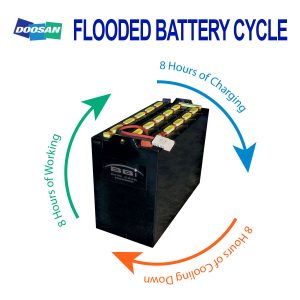Your forklift battery is the powerhouse of your electric forklift. On average, with proper care and maintenance, a forklift battery lasts about 5 to 7 years. To safely get the most out of your forklift battery, check out the 8 recommendations below.
1. Dress appropriately for handling batteries
Because forklift batteries are made from corrosive chemicals that can burn your eyes and skin, make sure to be dressed appropriately when handling batteries. Make sure to wear safety googles, rubber gloves, steel-toed boots, and an apron. Do not wear metallic jewelry.
2. Use the right handling equipment for moving batteries.
Forklift batteries are heavy. Smaller batteries can weigh 100-200lbs, but larger ones can weigh as much as 3,000lb. So, always use the appropriate handling equipment such as a battery lifting beam when lifting or moving batteries. Also, always make sure that the battery is properly secured before lifting or moving.
3. Handle and charge batteries in a designated area.
Having a designated area for handling and charging batteries is an OSHA-recommended best practice. When you charge your forklift battery, potentially flammable gases may be emitted. Having a designated, well-ventilated area prevents gas build-up. This designated area should also have eyewash and shower stations in the event of acid splashes and exposure.
4. Perform battery inspections and maintenance.
Batteries need to be inspected as a part of your daily OSHA-required forklift inspections. When inspecting your forklift battery, be sure to check your fluid levels. Make sure that the charging cables are intact, insulated, and connected. Look for cracks in the battery casing and for crystallization and corrosion. The battery’s contact posts should be clean.
5. Charge your batteries properly.
Properly charging your forklift battery is the best way to extend the life of your battery. A battery has a limited number of charge cycles in it, usually about 1,500 charges. Take care not to opportunity charge your battery. Flooded batteries should have 8 hours of run time, 8 hours of charge time, and 8 hours of cool-down time. If your operations require opportunity charging, see your battery supplier for the appropriate battery and charger combination for this type of charging capability.
To properly charge your battery, follow the below tips:
-
- Make sure that your battery and your battery charger are compatible.
- Be sure that the charger is off before connecting or disconnecting your battery.
- Charge your battery when it hits 20% charge remaining. Do not charge the battery before it hits this red zone.
- Always charge your battery completely. Partially charging your battery will count against your battery’s total number of charge cycles. Never interrupt a charging flooded type battery! (Unless you have an opportunity charger and battery combination.)
- Avoid extreme temperatures when charging your battery. Charging and operating your battery in extreme temperatures will greatly reduce your battery’s life.
- Allow your battery to cool down after charging. If you have a flooded or wet cell battery, you can follow the battery cycle of 8 hours charging, 8 hours cooling down, and 8 hours of working.

6. Check and maintain your battery’s fluid level.
As you use and charge your forklift battery, the fluid level of your battery decreases. That is why you should check the fluid level of your battery daily. You should add deionized or distilled water to your battery about every five to ten charges. Fill the cell with just enough water to cover the battery plate, usually about ¼” over the plate. Always add this water after charging, but never before charging. Also, do not overfill your battery because the water needs room to expand when the battery is in use.
7. Equalize your battery regularly.
Flooded, or wet cell, batteries need to be equalized on a regular basis. Over time, the water and acid in your battery become stratified. When this happens, your battery will not hold a charge well. By equalizing your battery, the electrolyte concentrate is rebalanced, and any buildup of sulfate crystals on the battery plate gets removed. Be sure to use a battery charger that has an equalizing setting.
8. Clean your battery regularly.
The top of your forklift battery needs to be cleaned regularly with battery cleaner or warm water regularly. Doing so is not only good maintenance practice; it can also help you maintain your battery’s manufacturer’s warranty. Also, cleaning can help you avoid battery build-up which can lead to tray corrosion and faster self-discharge.
Taking care of your forklift battery is greatly beneficial for your forklift and for your business’s bottom line. View original post HERE